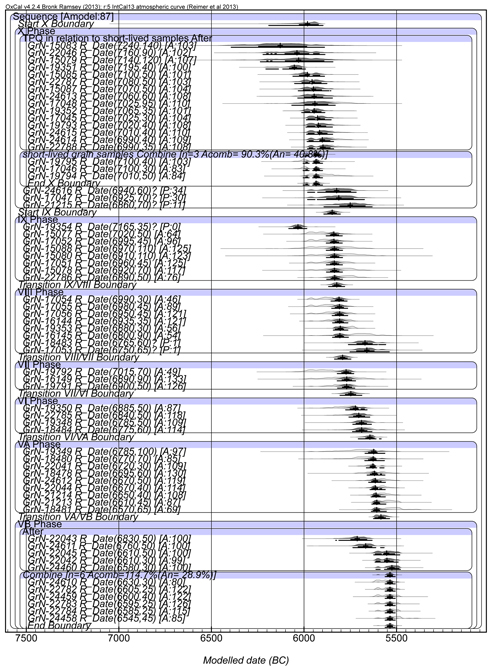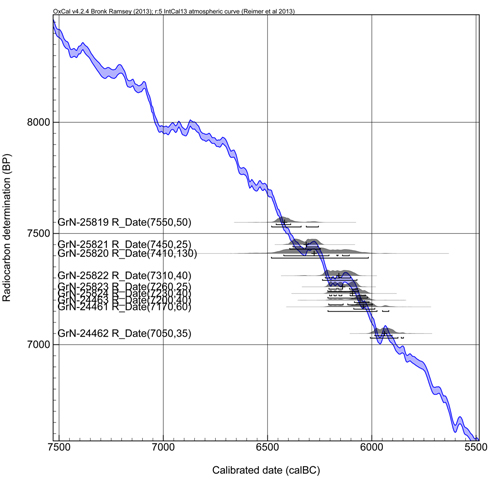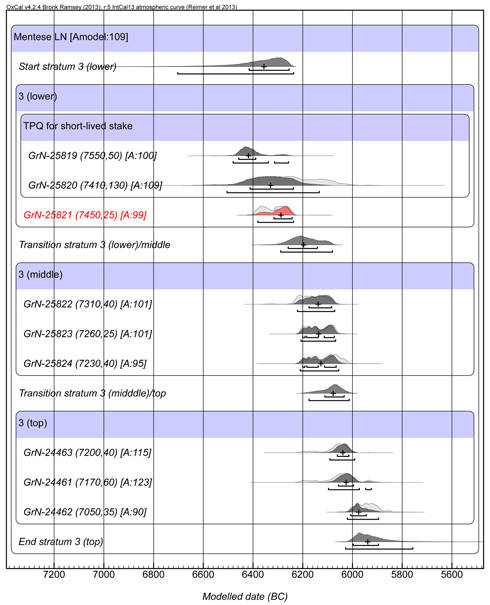 ...........................................................................................................
...........................................................................................................
Subregion Ia – Marmara
Table 1. Menteşe boundary model summary and median dates.
Ilıpınar
The majority of the 66 radiocarbon dates (excluding those from Late Chalcolithic Phase IV) are on (unidentified) charcoal, mostly occurring in the form of small concentrations on floors and courtyards, fills and from unspecified 'destruction layers' (Roodenberg & Schier 2001: 257), and only in one case the Groningen 14C database indicates the charcoal is from a charred beam (GrN-17045). Even though some of the charcoals might have derived from short-lived firewood (GrN-22046 from an oven; GrN-19791 from an 'ash pit'), all these dates on charcoal must be seen as generating TPQ events at best. Fortunately, there are two reliable data points within which the time interval covering Ilıpınar's Early Chalcolithic sequence can be caught, viz., the burning of Phase X and that of Phase VB. Three charred seed samples are dating the destruction of the last building level of Phase X; using the Combine command in OxCal yields a 1σ range between 5950–5910 cal BC indicating this event. From Phase VB six charred seed samples yield a combined result indicating a range between 5550–5520 cal BC for the fire destruction of Ilıpınar VB.
A sequential model, assuming the seven phases are contiguous, yields an unsatisfactory result (Amodel: 19), but a much better model (Amodel: 87) is gained when excluding some contextually doubtful dates contradicting the general sequence (GrN-24616, GrN-17047 and GrN-21215, all from Phase X, all too young, better at home in Phase VIII; GrN-19354 from Phase IX: too old, suggesting a Phase X intrusion; GrN-18483 and GrN-17053 from Phase VIII: too late, most likely Phase VI intrusions – compare Figure 3).

The estimated phase boundaries are as follows.
Table 2. Ilıpınar Early Chalcolithic (Phases X–VB) boundaries.
Middle Chalcolithic Ilıpınar Phase VB, with clear 'Balkan' parallels in a part of its ceramic assemblage, thus dates in the 56th mill. cal BC, making it just later than Aşağı Pınar 6 (median range at 1σ: 5720–5625 cal BC, but just earlier than Aşağı Pınar 5 (median range at 1σ: 5465–5225 cal BC). AP 6 being equated with Karanovo II (on the type site ranging between 5730–5635 cal BC), Ilıpınar VB would equate with the period Karanovo II–III, whereas Ilıpınar VI and VA parallel Karanovo II, Ilıpınar VIII Karanovo I.
Menteşe
Samples are all on (unidentified) charcoal, and two are from 'posts', though GrN-25821 from a stake of what is described as a storage feature, while GrN-24461 from a burnt building might be from a more substantial log. All data must be treated as providing termini post quos only, but at least the stake date was probably from short-lived material, so potentially a reliable date indicator for the approximate age of the site's basal deposit, subsumed as Phase 3 'lower occupation levels' (Roodenberg et al. 2003: 20) (Figure 1).

The Menteşe Phase 3 'top' deposit, destroyed by fire, suggests contemporaneity with Barcın Höyük's latest Late Neolithic level VIa, while its end might just predate the onset of settlement at Ilıpınar (Phase X) starting just within the 6000 cal BC boundary (see below). However, there is the youngest Menteşe date assigned to the same 'top' deposit (GrN-24462), that correlates perfectly with the end date of Ilıpınar Phase X (see below). Keeping in mind the nature of the Menteşe samples this young date either hints at an additional phase having existed at Menteşe contemporary with Ilıpınar X, or else implies a much longer occupation phase there ultimately overlapping with Ilıpınar X. Four dates crosscutting Phase 3 deposits 'middle' and 'top' are close to each other, indicating continuity between both occupations (Figure 2).

The stake date as a high-level date for the use-life of the structure and the associated house of Menteşe Phase 3 'lower', and assumed to be on short-lived material, thus a TPQ event to the two other dates, yields a satisfactory boundary model for the site's sequence (Amodel: 109). The model is compatible with the pottery evidence from nearby Barcın Höyük: the basal pottery from Menteşe is well comparable to Barcın phase VId3, yielding identical dark brown and reddish, densely calcite tempered vessels dominated by necked holemouth pots with two oppositional lugs on the shoulders and incised decorated vessels (Menteşe pottery, personal observation). On the basis of still unpublished 14C dates Barcın VId3 would date to somewhere in the 64th C cal BC.
Samples are all on (unidentified) charcoal, and two are from 'posts', though GrN-25821 from a stake of what is described as a storage feature, while GrN-24461 from a burnt building might be from a more substantial log. All data must be treated as providing termini post quos only, but at least the stake date was probably from short-lived material, so potentially a reliable date indicator for the approximate age of the site's basal deposit, subsumed as Phase 3 'lower occupation levels' (Roodenberg et al. 2003: 20) (Figure 1).

Figure 1. Menteşe dates on the calibration curve.
The Menteşe Phase 3 'top' deposit, destroyed by fire, suggests contemporaneity with Barcın Höyük's latest Late Neolithic level VIa, while its end might just predate the onset of settlement at Ilıpınar (Phase X) starting just within the 6000 cal BC boundary (see below). However, there is the youngest Menteşe date assigned to the same 'top' deposit (GrN-24462), that correlates perfectly with the end date of Ilıpınar Phase X (see below). Keeping in mind the nature of the Menteşe samples this young date either hints at an additional phase having existed at Menteşe contemporary with Ilıpınar X, or else implies a much longer occupation phase there ultimately overlapping with Ilıpınar X. Four dates crosscutting Phase 3 deposits 'middle' and 'top' are close to each other, indicating continuity between both occupations (Figure 2).

Figure 2. Menteşe boundary model using a TPQ hypothesis grouping GrN-25819 and GrN-25820 treating GrN-25821 (in red) as a short-lived sample. The result (Amodel: 109) harmonises the dating with the archaeological (ceramics) evidence (see text).
The stake date as a high-level date for the use-life of the structure and the associated house of Menteşe Phase 3 'lower', and assumed to be on short-lived material, thus a TPQ event to the two other dates, yields a satisfactory boundary model for the site's sequence (Amodel: 109). The model is compatible with the pottery evidence from nearby Barcın Höyük: the basal pottery from Menteşe is well comparable to Barcın phase VId3, yielding identical dark brown and reddish, densely calcite tempered vessels dominated by necked holemouth pots with two oppositional lugs on the shoulders and incised decorated vessels (Menteşe pottery, personal observation). On the basis of still unpublished 14C dates Barcın VId3 would date to somewhere in the 64th C cal BC.
—L.T.
| Boundaries | Cal BC (1σ) | Median | Correspondence |
| Boundary Start Phase 3 (lower) | 6430–6250 | 6360 | Barcın VId3 |
| Transition Phase 3 lower / middle | 6260–6140 | 6200 | Barcın VIc / VIb |
| Transition Phase 3 middle / top | 6120–6030 | 6080 | Barcın VIb / VIa |
| Boundary End Phase 3 (top) | 6000–5890 | 5940 | Barcın VIa / Ilıpınar X |
Ilıpınar
The majority of the 66 radiocarbon dates (excluding those from Late Chalcolithic Phase IV) are on (unidentified) charcoal, mostly occurring in the form of small concentrations on floors and courtyards, fills and from unspecified 'destruction layers' (Roodenberg & Schier 2001: 257), and only in one case the Groningen 14C database indicates the charcoal is from a charred beam (GrN-17045). Even though some of the charcoals might have derived from short-lived firewood (GrN-22046 from an oven; GrN-19791 from an 'ash pit'), all these dates on charcoal must be seen as generating TPQ events at best. Fortunately, there are two reliable data points within which the time interval covering Ilıpınar's Early Chalcolithic sequence can be caught, viz., the burning of Phase X and that of Phase VB. Three charred seed samples are dating the destruction of the last building level of Phase X; using the Combine command in OxCal yields a 1σ range between 5950–5910 cal BC indicating this event. From Phase VB six charred seed samples yield a combined result indicating a range between 5550–5520 cal BC for the fire destruction of Ilıpınar VB.
A sequential model, assuming the seven phases are contiguous, yields an unsatisfactory result (Amodel: 19), but a much better model (Amodel: 87) is gained when excluding some contextually doubtful dates contradicting the general sequence (GrN-24616, GrN-17047 and GrN-21215, all from Phase X, all too young, better at home in Phase VIII; GrN-19354 from Phase IX: too old, suggesting a Phase X intrusion; GrN-18483 and GrN-17053 from Phase VIII: too late, most likely Phase VI intrusions – compare Figure 3).

Figure 3. Ilıpınar sequence boundary model.
The estimated phase boundaries are as follows.
| Phase boundaries | 1σ range cal BC | Median 1σ | |
| Start Phase X | 6030–5920 | 5980 | |
| N=3 grain samples | 6000–5980 (8.4%) 5950–5910 (59.8%) | 5940 | Acomb=90.3% |
| End Phase X | 6000–5980 (8.4%) 5950–5910 (59.8%) | 5940 | |
| Start Phase IX | 5880–5820 | 5850 | |
| Transition IX/VIII | 5850–5800 | 5820 | |
| Transition VIII/VII | 5820–5760 | 5790 | |
| Transition VII/VI | 5780–5720 | 5750 | |
| Transition VI/VA | 5680–5620 | 5650 | |
| Transition VA/VB | 5620–5560 | 5590 | |
| N=6 grain samples | 5560–5520 | 5540 | Acomb=114.7% |
| End Phase VB | 5560–5520 | 5540 |
Middle Chalcolithic Ilıpınar Phase VB, with clear 'Balkan' parallels in a part of its ceramic assemblage, thus dates in the 56th mill. cal BC, making it just later than Aşağı Pınar 6 (median range at 1σ: 5720–5625 cal BC, but just earlier than Aşağı Pınar 5 (median range at 1σ: 5465–5225 cal BC). AP 6 being equated with Karanovo II (on the type site ranging between 5730–5635 cal BC), Ilıpınar VB would equate with the period Karanovo II–III, whereas Ilıpınar VI and VA parallel Karanovo II, Ilıpınar VIII Karanovo I.
—L.T.



 up
up